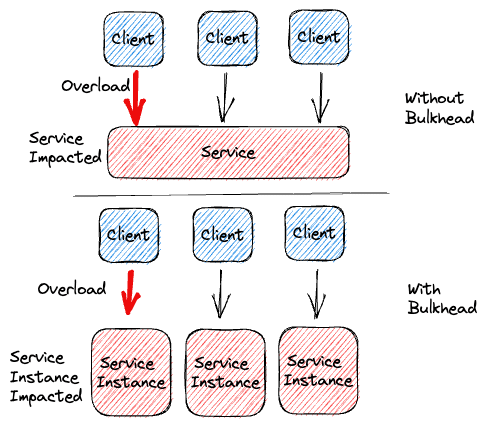Bulkhead Pattern Performance
In this tutorial, we are going to discuss about the Bulkhead Pattern Performance Implications and Special Considerations.
Implementing the Bulkhead Pattern in distributed systems has several performance implications and requires special considerations to ensure it provides the intended benefits without introducing new issues. Below, we discuss the performance implications and special considerations of the Bulkhead Pattern in detail.

Performance Implications
1. Resource Allocation Overhead
- Increased Resource Utilization: Each bulkhead (isolated service or component) requires its own dedicated resources, such as memory, CPU, and thread pools. This can lead to increased overall resource usage compared to a shared resource model.
- Higher Costs: Allocating dedicated resources to each bulkhead can lead to higher operational costs, especially in cloud environments where resources are billed based on usage.
2. Latency
- Inter-Service Communication: Increased isolation can lead to more inter-service communication, which may add latency, especially if services are deployed across different nodes or regions.
- Network Overhead: Network calls between isolated services can introduce additional latency and potential points of failure.
3. Complexity in Load Balancing
- Resource Management: Managing and balancing resources across multiple bulkheads can be complex, requiring sophisticated load balancing strategies to ensure optimal performance.
- Auto-Scaling Challenges: Implementing auto-scaling policies for each isolated component can be challenging, requiring careful tuning to avoid over- or under-provisioning.
4. Startup Time
- Service Initialization: Isolated services may have longer startup times due to the need to initialize separate resources and connections.
Special Considerations
1. Granularity of Isolation
- Appropriate Granularity: Determine the appropriate level of granularity for isolation. Too coarse-grained isolation may not provide sufficient fault tolerance, while too fine-grained isolation can lead to resource inefficiencies and increased complexity.
- Critical Path Analysis: Identify critical paths in the application workflow and ensure that key services in these paths are adequately isolated.
2. Resource Configuration
- Right-Sizing Resources: Carefully configure resource limits and requests to balance performance and cost. Monitor resource usage and adjust configurations as necessary.
- Dynamic Allocation: Consider using dynamic resource allocation techniques to adjust resources based on real-time demand.
3. Circuit Breakers and Timeouts
- Appropriate Thresholds: Set appropriate thresholds for circuit breakers to prevent cascading failures without prematurely cutting off services.
- Timeouts: Implement timeouts for inter-service calls to prevent long wait times and resource blocking.
4. Monitoring and Observability
- Comprehensive Monitoring: Implement comprehensive monitoring for each isolated service, tracking metrics such as CPU, memory usage, request latency, and error rates.
- Centralized Logging: Use centralized logging to aggregate logs from all services, making it easier to trace issues and understand system behavior.
5. Testing and Fault Injection
- Resilience Testing: Regularly test the system’s resilience by simulating failures and observing how the bulkheads contain the impact.
- Chaos Engineering: Use chaos engineering practices to inject failures and validate that the isolation mechanisms are working as intended.
6. Service Discovery and Load Balancing
- Service Discovery: Use robust service discovery mechanisms to manage the dynamic nature of service instances.
- Intelligent Load Balancing: Implement intelligent load balancing to distribute traffic effectively across isolated services.
7. Determining the Bulkhead Sizes
- One of the challenges of implementing the Bulkhead pattern is determining the appropriate sizes for the bulkheads or thread pools. Ideally, these should be decided based on the expected load and nature of the tasks or services. However, striking the right balance often involves a degree of trial and error.
8. Monitoring and Adjusting the Bulkheads
- Over time, as the load and nature of tasks evolve, the initial allocations may need adjustments. It’s crucial to monitor the system’s performance and adjust the bulkhead sizes as needed. Tools like Java’s VisualVM can help monitor thread usage and identify potential bottlenecks.
9. Error Handling
- Even with bulkheads, some requests may fail or be excessively delayed if a service goes down or becomes unresponsive.
- It’s essential to handle these scenarios gracefully, perhaps by implementing a timeout or using another resilience pattern, like the Circuit Breaker, which we discussed in our previous chapter.
10. Scalability Concerns
- While the Bulkhead pattern improves system resilience, it doesn’t directly address scalability. If the system load increases significantly, simply creating more threads might lead to excessive context switching and eventually decrease performance. In such cases, it’s worth exploring other scalability strategies, like horizontal scaling (adding more machines) or using asynchronous processing.
Do these implications make the Bulkhead pattern less attractive? Absolutely not! On the contrary, understanding these considerations equips us to use the pattern more effectively. It’s like knowing the strengths and weaknesses of a chess piece. The queen is undoubtedly powerful, but a player who also knows when to strategically use a pawn or a knight has the upper hand.
Likewise, the Bulkhead pattern, despite its considerations, is a potent tool in building robust distributed systems. Can you think of scenarios in your projects where the Bulkhead pattern could enhance resilience? As we explore some common use cases in the next part of this chapter, you might identify situations where the Bulkhead pattern could be your knight (or queen!) in the strategic game of distributed systems design. Let’s continue our journey!
Conclusion
Implementing the Bulkhead Pattern in distributed systems enhances resilience and reliability by isolating failures. However, it requires careful planning and consideration of resource allocation, monitoring, and service management to avoid potential performance issues. By addressing these considerations, you can effectively use the Bulkhead Pattern to build robust and maintainable distributed systems.
That’s all about the Bulkhead Pattern Performance Implications and Special Considerations. If you have any queries or feedback, please write us email at contact@waytoeasylearn.com. Enjoy learning, Enjoy Microservices..!!